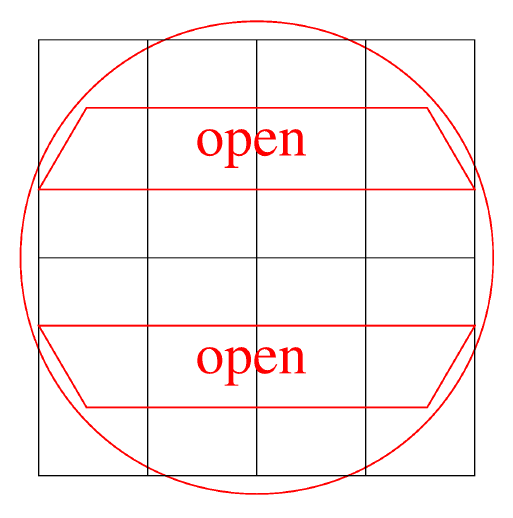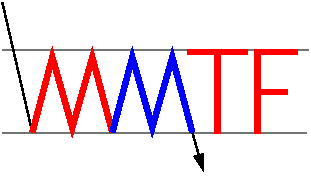The charge shuffling / frequency switching mode enables the observer to switch among 2-3 central wavelengths during a single exposure. The procedure is as follows:

Diagram of the aperture mask used in charge shuffling / frequency switching mode. The black outline shows the 8 CCD chips, and the red outline the aperture mask. The "open" segments are illuminated.
Each IMACS CCD is first divided into three equal segments by an aperture mask. The aperture allows light only onto the center third of each chip (see figure at right). When the exposure begins, the center of each chip is exposed at a single wavelength. With the shutter closed, the accumulated charge is then (almost instantaneously) moved down one-third of the chip length. The etalon's central wavelength is changed (again, almost instantaneously). The exposure proceeds at this second wavelength, again at the center of the chip, for a time equal to twice that at the first wavelength. The charge is then shuffled back up, and integration proceeds at a third wavelength atop the accumulated charge from the first part of the exposure for a time equal to that at the first wavelength. The procedure is then repeated. At the end of the exposure, each chip contains two images of the same field, each on one-third of the chip. The last third is empty.
The third wavelength may equal the first, to produce two monochromatic images. Alternatively, it may be unique from the other two. In this case one of the resulting images is the sum of images at two separate wavelengths. Each wavelength in this image experiences one-half the exposure time of the other image.
This procedure allows significant improvements in relative photometry. Time variations in transparency and seeing are matched between images at two different wavelengths, using a cadence chosen by the observer. A second advantage of charge-shuffling is that it allows accurate matching in wavelength space of the continuum of an emission-line source. If one image traces an emission-line, the other can trace the continuum at one or two immediately adjacent wavelengths.
Things to consider when using this observing mode:
- Only a single filter can be in use during charge-shuffling, but within that filter any wavelength is allowed.
- The time overhead for charge shuffling and changing wavelengths is limited by the shutter speed, since the shutter is closed before the charge is moved on the chip, and re-opened after the shuffle. (The time required to move the charge and etalon response time are negligible.)
- The exposure time between charge shuffles is left up to the observer.
- Only 1/3 of the field-of-view is illuminated during a given exposure. Thus, for observations of sources or fields covering the field of view, the camera must be dithered at least twice on 5' scales to fill in the gaps.
- The voltage applied to the CCD chips for charge shuffling is different than for normal operation. This results in saturation effects when bright sources are in the field. We caution against observing fields containing very bright stars.

